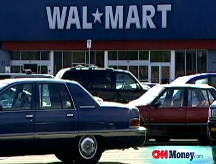Wall Street: Three cheers for the bear
Stocks, on average, have risen in the one, two, three, six and 12 months following bear markets since the 1950s.

NEW YORK (CNNMoney.com) -- In classic contrarian style, some Wall Street pros are happy the bear is back.
No, they aren't sadistic. It's just that in the majority of bear markets going back to the 1950s, stocks, on average, rose soundly during the one, two, three, six and 12 months after the markets were first labeled as bears. A bear market is typically defined as a drop of at least 20% off the cyclical highs.
As of Tuesday, all three major gauges are in bear market territory, having closed down at least 20% off the October highs, or in the case of the S&P 500, 19.9% (which S&P considers close enough to be called a bear). On the upside, the bloodletting means a big recovery for all three indexes could be in the works.
"It's often when the market feels so terrible that that's when the best opportunities arise," said Katie Townshend, chief market technician at MKM Partners. "When everyone jumps on the bear."
Townshend said a variety of factors she looks at are in that 'so bad it's not so bad' category of contrarian indicators, including measures of investor sentiment and the percentage of stocks in the S&P 500 that have been beaten up enough to warrant being called "oversold."
For example, she said investor sentiment as measured by research firm Investors Intelligence is at its most bearish since March. And the latest survey from the American Association of Individual Investors (AAII) shows sentiment at its most bearish since June and near the peak levels hit in January.
Meanwhile, the percentage of S&P 500 stocks that are oversold on both a daily and weekly basis are at the highest levels since March. The weekly level, which is the more long-term indicator, shows that 60% of S&P stocks are oversold, up from 54% in January, she said.
"The major gauges feel like they did going into the March lows," Townshend said. That decline led to a bounce through mid-May that the market has since erased. But a longer-term outlook could be the key.
She said that the market, as demonstrated by the S&P 500, is sitting at a critical point right now and that if it can end the current week without big losses, it will be in good shape to see a bounce several months out.
Minding the bears. Going back to 1956, there have been 9 other bear markets, according to Standard & Poor's chief investment strategist Sam Stovall.
According to Stovall, the S&P typically fell into bear territory about 9 months after the previous market top and the average bear market lasted about 14 months. The current market peaked in October - around 9 months ago.
Looking at stock market performance in the year after hitting bear market territory, Stovall found that the average results were always positive. In the one, two, three, six and 12 months after seeing a bear, the S&P 500 gained an average of 3%, 5.6%, 4.7%, 6.7% and 16.5%, respectively.
Bill Stone, chief investment strategist at PNC Financial Services Group also conducted a survey of stock performance in the months after first falling into bear market territory and found equally promising results.
But there are of course exceptions. Big ones. "1973 was bad," Stone said. The S&P 500 was down 27% around 12 months after that bear.
The end of the early 2001 bear market also proved unimpressive, Stone said, with the S&P 500 down 1.2% a year later.
But the aftermath of the most recent bear market was more positive.
Wall Street last saw a bear in 2002, following the collapse of the late 1990s tech bubble, the recession of 2001 and the 9/11 terrorist attacks. That year, the Dow was in a bear market for about 7 months and dropped 31.5%, according to the Stock Trader's Almanac, while the S&P 500 was in a bear market for 9 months and shed almost 46%. The Nasdaq was also in a 9-month bear market and lost nearly 34%.
After bottoming in October 2002, stocks rallied back more or less for the next 5 years, seeing the third-longest bull market in history before hitting the current hump. Between the October 2002 lows and the October 2007 all-time high for the S&P 500, the index gained 101%.
Other big bounces happened in 1980, 1987 and 1990. In all three instances, the S&P 500 was up at least 20% six months later.
On the downside, bear markets don't typically end once the index in question has slumped 20%. Some last a lot longer. On the upside, bear markets don't typically last as long nowadays as they used to, with the biggest collapse in history happening in 1929 - a year that is unlikely to be replicated. ![]()



